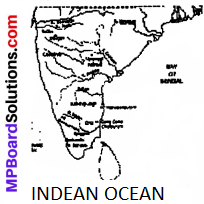In this article, we will share MP Board Class 7th Social Science Solutions Chapter 2 Kingdoms of the South India Pdf, These solutions are solved subject experts from the latest edition books.
MP Board Class 7th Social Science Solutions Chapter 2 Kingdoms of the South India
MP Board Class 7th Social Science Chapter 2 Text Book Questions
Choose the Correct answer from the given alternatives:
Mp Board Class 7th Social Science Solution In English Question 1.
Which ruler of the Pallava dynasty defeated Pulakeshin 11 and assumed the title of Vatapikonda?
(a) Mahendra Vamian
(b) Narsimha Varmaa
(c) Aparajit Varman
(d) Yasho Verman
Answer:
(b) Narsimha Varmaa
Social Science Class 7th Mp Board Kingdoms of the South India Question 2.
Which ruler of the Rashtrakuta dynasty built the Kailasha temple at Ellora?
(a) Krishna – I
(b) RajaDhruva
(c) Krishna – II
(d) Rayendral
Answer:
(a) Krishna – I
Class 7th Social Science Chapter 2 Mp Board Kingdoms of the South India Question 3.
Who translated Ramayan into Tamil
(a) Valmiki
(b) Tulsidas
(c) Kamban
(d) Adi Shankaracharya
Answer:
(c) Kamban
Fill in the blanks with appropriate words given in the brackets:
- The capital of the Pallava Kingdom was ……………. (Thiruvananthapuram, Tanjore, Kanchipuram).
- The Rajarajeshwara (Brihadeshwara) temple built by the Cholas is situated at ………. (Thiruvananthapuram, Tanjore, Kanchipuram).
- The districts in the Chola period was known as …………….(Ur, Mandalam, Valalnadus).
Answer:
- Kanchipuram
- Tanjore
- Valanadus
MP Board Class 7th Social Science Chapter 2 Short Answer Type Questions
Mp Board Class 7th Social Science Solution In English Medium Question 1.
Give one main reason for the contact between the North and South India from 8th to 12th century.
Answer:
The various rulers of South India invited the Brahmans of North India to settle in the South for teaching and performing religious practices. This proved to be the main reason for the contact between the North and the South.
Mp Board Class 7 Social Science Chapter 2 Kingdoms of the South India Question 2.
Which province of the Chola province was known as “Mumadi Chola Mandalam”?
Answer:
The Northern part of Sri Lanka became a Chola province under the name of “Mumadi Chola Mandulam”.
Mp Board Class 7th Social Science Kingdoms of the South India Question 3.
Give two examples of the architecture of the Chola period.
Answer:
Two examples of the architecture of die Chola period:
- The Rajarajeshwara temple of Tanjore.
- The various temples at Gangaikondacholapuram
Mp Board Class 7th Social Science Chapter 2 Kingdoms of the South India Question 4.
Mention the names of three kings of the Rashtrakuta dynasty.
Answer:
The names of three kings of the Rashtrakuta dynasty:
- Krishna – I
- Govinda – II
- Dharavarsha Govind – III.
MP Board Class 7th Social Science Chapter 2 Long Answer Question
Class 7th Social Science Mp Board Kingdoms of the South India Question 1.
Mention the main features of the Chola government.
Answer:
The main features of the Chola government can be stated as under:
- Though the Chola kings had vast powers, yet they used to consult their ministers and even Purohita.
- There was decentralization: from center into mandalams, mandalam into valanadus. The administration was divided into numerous departments. The village administration was carried on by village authorities.
- The Chola kingdom received revenue from
- land
- trade part ofrevenue collection Was kept forking’s expenditure.
- The Chola kings spent money on the promotion of the art, literature and spread of education.
- The Chola kings took active interest in temple-building, architecture, sculpture, painting and music.
Mp Board Solution Class 7 Social Science Kingdoms of the South India Project Work
On an outline map of India show the capitals of the various dynasties of South India.
Answer:
